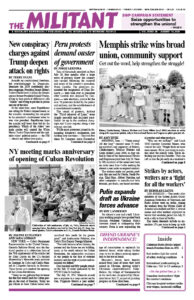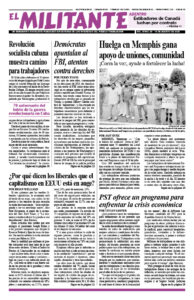Tens of thousands marched in Peru July 19, four months after a large wave of protests threw the country into turmoil following the removal and arrest of the country’s president, Pedro Castillo. The protesters demanded the resignation of Dina Boluarte — who took over as president after Castillo was deposed by Congress — new elections, justice for the over 70 protesters killed by the police and military, and the establishment of a constitutional assembly.
The round of protests, dubbed the “Third takeover of Lima,” were largely peaceful and included roadblocks set up in the southern Arequipa and Cusco regions along a key mining corridor.
While most protesters joined in demanding Boluarte’s resignation and holding new elections — rejected five times by Congress since December — they are divided on demanding Castillo be restored to office. Many say Castillo, who had been a schoolteacher, union leader and peasant, was removed because he was considered “a man of the people.”
“We demand that our vote be respected, otherwise it has no value,” Sonia Quispe, a teacher in Cusco, told the Militant by phone. Others had become disillusioned over his performance as president.
The July 19 actions were called by the National Coordinator of Unified Struggle (CNUL), a block of diverse social organizations and political forces, along with the Workers’ General Confederation of Peru, the country’s main trade union federation.
The capitalist rulers have been unable to form a stable government, with six presidents in the last five years. This political volatility is fueled by longstanding anger among working people over conditions imposed by Peru’s government and imperialist interests, as economic growth has expanded in the major copper-producing country.
In Cusco some 3,000 small shopkeepers, teachers, construction workers and others marched around the main plaza, Mary Luz Bastidas said in a phone interview. Unfortunately tourist industry workers, a big sector of the workforce in Cusco, had not joined the action, she said.
Before the protests, the government mobilized 24,000 police and military personnel, including along the country’s main highways. They were seeking to obstruct protesters heading to Lima, the capital. The country’s prime minister, Alberto Otárola, said a state of emergency, which suspends certain rights, including the freedom of movement, would help keep roads open as Peru celebrated its Independence Day July 28.
Rulers control copper, agriculture
The state of emergency was imposed in Peru’s southern regions of Apurimac, Cusco and Arequipa, home to some of the country’s largest mines, including Las Bambas, one of the world’s most productive copper mines, owned by China’s MMG Ltd. and CITIC Metal.
Lucio Castro, leader of the national teachers union SUTEP, told La República they are demanding 6% of the gross domestic product be used for education. “Education in the country is in total abandonment, and that needs to be reversed.”
A big portion of Peru’s workforce is hired by contractors or work in the “informal” economy. According to the National Institute of Statistics and Information of Peru, more than 12 million workers are in the informal economy, mostly women.
Peru’s capitalist class, ruling over a population of 34 million, depends on control over agricultural production, as well as exports of copper and other minerals.
“The land question has not been resolved in Peru,” Edgar Carrasco, a street vendor, told the Militant during a wake held in Lima July 7 for Hugo Blanco, a revolutionary organizer of the peasantry in the 1950s and ’60s who died June 25. “Food production went from being controlled by the landowners to the agro-exporter conglomerates. This is a central question driving the protests.”
Many of the mobilizations by indigenous groups and peasants in the last decade have protested against the impact of large-scale capitalist mining operations, which provide relatively few jobs for the local population. These operations have led to the destruction of agricultural land and water resources, and forced the relocation of thousands.
Felix Suasaca, a representative of the National Platform of People Affected by Toxic Metals, said that some 10 million Peruvians, 31% of the population, are exposed to heavy metals in the water that they drink, mainly from the mining industry.
Róger Calero contributed to this article.

